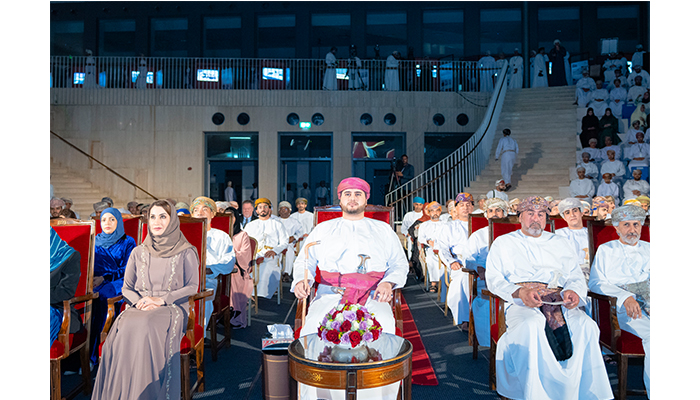
Muscat: His Highness Sayyid Bilarab bin Haitham Al Said patronised over the closing ceremony of the 2nd edition of Bilarab bin Haitham Award (BHA) for Architectural Design at the German University of Technology in A’Seeb, Muscat on Tuesday evening.
The top three wining projects of the BHA’s 2nd version were announced during the ceremony, as well as naming the winner of the contest on designing the Sultanate of Oman’s pavilion at Expo Japan 2025.
In his opening speech, HH Sayyid Bilarab bin Haitham Al Said underlined the positive interaction witnessed by the public in the second edition of the award and the achievement of its goals being a gateway for young people towards providing them with the opportunity to highlight their capabilities and implement them on the ground, thus making the award a success.
He added the award will continue to renew its ideas, benefiting from the experience gained during the first and second cycles.
He expressed his sincere thanks to the Omani youth who participated and interacted with the award during the second version. He also congratulated the winners of the first places and those who qualified for the final stage of the award, the competition to design the Sultanate of Oman’s pavilion at Expo Japan 2025. He called on those who were not fortunate enough to reach the podium not to despair, urging them to strive to develop their skills and abilities, in a manner that qualifies them for any upcoming competitions.
Mohammed Salah Al Balushi won the first place for his design inspired by the scene of the gathering of ships in Khor Al Battah in the Wilayat of Sur during periods of prosperous maritime activity. The building of Sur Maritime Museum was designed to embody the Omani maritime heritage at the peak of its prosperity with the aim of reviving this history.
In addition to the basic components of the museum, the project includes a main walkway "Boulevard" containing cafes, restaurants and a park, as well as another walkway overlooking the sea, linking the sea street walkway to Khor Al Battah Bridge and the Ship Factory.
The project also includes a public square that contains an open theater overlooking the coast, in addition to office spaces. All these components are directly related to the urban structure of the region, as all spaces and services can be used separately from the museum.
The second place went to Al Moataz Abdullah Al Nabri. The design idea is characterised by its response to the routes of maritime traffic between the eastern and western axis. It blends with the surrounding urban environment. It also reflects the movement of Omani sailors that extended to the coasts of western India and eastern Africa. Visitors will enjoy a journey through a series of exhibition spaces extending towards the west, while the eastern side of the building houses most of the operations and services.
One of the most important elements of the building is the dynamic, wind-responsive façade that seems to undulate smoothly as the wind energizes the dangling metal panels, in response to the ever-changing wind patterns. The flowing movement on the outside surface refers to the white sails, while the inside gives a view of the shimmering ripples to simulate fish scales and the reflection of the sun on the moving water.
As for the third place, it went to the team consisting of Ammar Salah Al Saleh, Mohammed Khodabakhsh Al Balushi and Rawnaq Rashid Al Ismaili. The team’s project’s idea was inspired by the voyage of the Omani sailors where the journey begins with traditional songs and folklore as bidding farewell through the alleys and residential neighborhoods until they reach the sea, where they sail in small scattered boats to the vessel of the voyage, before it makes its way in the ocean and sets off on its journey. The idea of designing this project aims to provide the visitor with the opportunity to experience the voyage of the ancient Omani sailor in real details, accompanied by arts, songs and marine sciences.
The appreciation award the jury was won by the team consisting of Ammar Abdulhameed Al Kiyoumi, Firas Nasser Al Hashar, and Moayad Mubarak Al Araimi. “Mast Al Khor” project aims to reflect Oman's maritime history architecturally. The external shape of the project is inspired by the beauty and complexity of Omani ships, in consistency with the landscape of the general horizon of the city of Sur. The project includes a public outdoor arena for community activities, a boarding path, and a viewing platform.
The winning project in the competition to design the Sultanate of Oman’s pavilion at Expo Japan 2025 was announced. It was a team consisting of Bayan Musallam Al Ramadani, Ammar Abdulhameed Al Kiyoumi, and Nayera Khamis Al Hinai.
On the sidelines of the ceremony, an accompanying exhibition was held, which reviewed the ten projects qualified for the final rounds, and their technical details in audio and video.